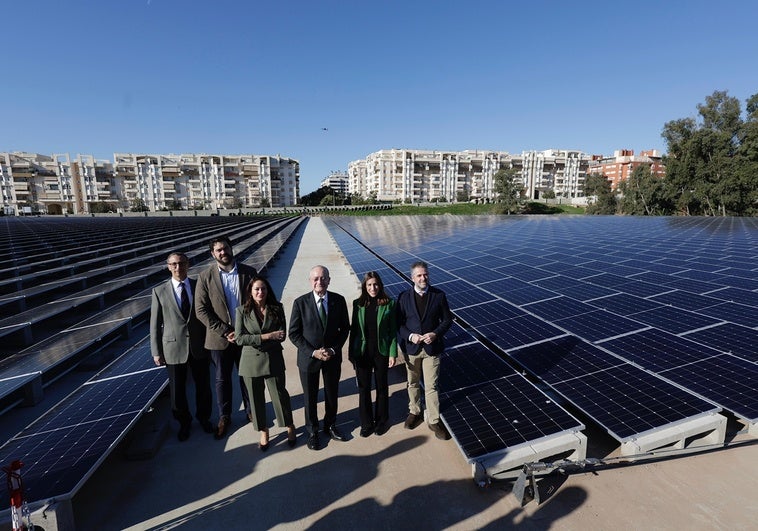
Malaga council installs the largest urban photovoltaic plant in Spain
The sea of 4,200 solar panels on the roof of an Emasa water reserve in the Teatinos distrcit will generate 17.5 per cent of the electricity needed by the Atabal desalination plant
Malaga city council has installed the largest solar photovoltaic plant in an urban environment in Spain, precisely in the Teatinos neighbourhood, where a large Emasa drinking water storage reserve is located. The inauguration of the plant on Monday was attended by Mayor of Malaga Paco de la Torre and environment councillor Penélope Gómez, among others. What looks like a sea of solar panels on the roof of the municipal company, with 4,200 modules (5,531 in total with those installed at the El Atabal water treatment plant, which are part of the same installation) has two basic objectives: firstly, to save on electricity consumption; and secondly, to combat climate change, as their use means a reduction in the use of other polluting energies that cause the emission of CO2 into the atmosphere.
De la Torre stressed that Malaga is aligned with European objectives and the promotion of renewable energies. In this context, he highlighted that energy prices rose drastically in 2022, which led them to request aid from the government, though they did not receive it. "However, we did not pass on the cost of this increase to the consumer," he stated, noting that significant municipal efforts were made to address the 4.2 million euro additional charges billed by electricity companies in Malaga's water cycle, from 13 million in 2022 to 8.8 million in 2023. He also said that this is why it was necessary to make an adjustment in water tariffs, "to help meet the challenges of the drought".
The 5,255 megawatts/hour that this facility will produce per year would be capable of supplying some 2,000 homes annually, as explained by Gómez. However, its use will be exclusively for the self-consumption of Emasa's facilities. The desalination plant at El Atabal needs enormous amounts of electricity to carry out the reverse osmosis process and eliminate the salt from the water of the Guadalhorce reservoir complex. In fact, as Gómez explained, the desalination plant needs a power of 49 gigawatts/hour per year, so the current solar plant would be capable of supplying 17.5 per cent of the total annual consumption.
Gómez gave an account of the costs, three million euros, which have been co-financed thanks to the European Next Generation funds. The photovoltaic panels are located on top of a 100,000 cubic metre water tank in Calle Mesonero Romanos, which is almost enough to supply the city of Malaga for a day (specifically, Malaga has a daily consumption of 130,000 cubic metres).
In addition to the inauguration of this plant, Malaga city council has already launched the contracting of the second phase, with photovoltaic solar panels on the rest of the water treatment plant's roofs, car park and on land currently unused by the station itself. The drafting of the project and the execution of this second phase has been put out to tender for 972,000 euros (IVA sales tax included), of which 557,000 euros will also be co-financed by the European Union through the same Next Generation funding programme.
The Teatinos photovoltaic plant is also the largest solar power plant of the total of 71 active photovoltaic installations in municipal facilities. In addition to the 17.5 per cent saving on electricity bills, the photovoltaic installation will help to reduce carbon dioxide emissions into the atmosphere by 2,400 tonnes per year. As for the second phase, it is expected to add a peak power of 857 kilowatts and the capacity to generate a further 1,290 megawatt hours.
